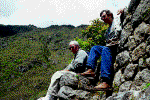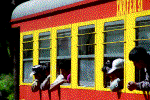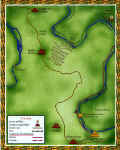Cusco still holds marvels and mysteries waiting to be
discovered. While the city, its neighborhoods, provinces, people and history are known
worldwide, there have been new discoveries in recent years. The Inca path to purification is one of
them.

We leave Lima bent on following this trail to discover its mysteries and beautiful landscape for ourselves. We had heard wonderful things about the trail and were eager for adventure. Neither weather nor harsh landscape could deter us.
In the town of Machu Picchu, we began our three-kilometer hike, following the river upstream. Provisioned only with the excitement of possible discoveries, a bit of food and our cameras, we made our way to the Choquesuysuy ruins, which until then had only been seen from afar by locals or curious train passengers.
At the Machu Picchu Pueblo Hotel the day before, we had persuaded Jose
Koechlin, who discovered the ancient Inca trail that links the Choquesuysuy ruins with those of
Wiñaywayna, to be our guide.
Toward purification
We left the town of Machu Picchu (Aguas Calientes), and at kilometer 100 crossed to the left bank of the Vilcanota or Urubamba River. We hiked three kilometers along paths cut through the cloud forest and over Inca terraces, crossing to the right bank of the river on a metal bridge. Another 300 meters, and we crossed the river once more, this time on a hanging bridge.
Here we began the ascent to Choquesuysuy. After leaving behind the archaeological complex, we headed toward
Wiñaywayna and, from there, via the traditional Inca Trail, continue at full speed to the sacred city of Machu Picchu.
From the hanging bridge over the Urubamba River, the trail rises some 80 meters toward Choquesuysuy. Continuing along the so-called Purification Trail, we followed the sound of rushing water toward the Quetzal Falls. About 100 meters higher up, supporting ourselves on the ancient, sturdy retaining walls, in the midst of an amazing cloud forest, we found that the falls plummet more than 60 meters. When we were just short of the mouth of the falls, a golden-headed quetzal swooped down only to peel off an instant later, tearing at the air in the narrow gorge. We tried to imagine why the ancients chose this spot to build their Purification Trail. Some holes in the rocks serve as granite steps that take the breath away as they lead along the very edge of the water: it is the continuation of the Winaywayna trail, which is behind the falls.
Excitement encouraged us to continue climbing, but the trail became a challenge because of the steep incline and the dense vegetation.
Choquesuysuy's archaeological value
Fine gold (choque) is washed, sifted or separated (suysuy) from the earth (Pachamama) that surrounds it. Here it is possible to see the soul cleansed or purified. The purification bath was the first step to being accepted by the Andean gods, everything that is sacred (huaca) and the ancestors (mallki)
Choquesuysuy--gold washing--is a site of pure water. Not everyone in Tawantinsuyo was allowed to manage water. Royal water keepers controlled how irrigation water was used, and here they managed the fountains very meticulously so that the waters would last forever (Winaywayna means “forever young”).
Since its discovery, this Inca Purification Trail (Choquesuysuy-Winaywayna-Machu Picchu) is considered by both locals and outlanders as the principal historic entrance to the sacred city of Machu Picchu, a necessary step to cleanse the spirit.
Visitors cannot help but be impressed by the five massive water fountains (paqcha) at the base of the archaeological complex. They are believed to represent the first cleansing before reaching Choquesuysuy itself. Researchers believe it is possible that offerings were left here.
Archaeologist Julio Cordova, of the San Antonio Abad National University in Cusco, says the many strange and one-of-a-kind stone circles in Choquesuysuy could be sites where the ancients spent the night awaiting the sunrise. Each could represent an important resting place for the residents of above (hanan) and those of below (hurin). The fact that the circles are oriented toward the rising sun in the form of a several-storied altar confirms their purpose: purification. The entire complex is geared toward this singular spiritual event.
Tourism and culture
Restoration work on the trail to Winaywayna will open the main access route to Machu Picchu, which, in all probability, was used only by the Inca ruling caste. A team consisting of archaeologists and biologists will carry out a rigorous cataloging of flora, fauna and archaeological remains.
The restoration work is made possible thanks to resources from private tourism companies. The Machu Picchu Pueblo Hotel will be in charge of the work, which will be
supervised by the director of the Machu Picchu Archaeological Park, archaeologist Ernesto
García Calderón.
In 1998, the sacred city of Machu Picchu was visited by 334,563 tourists and 66,188 hiked the Inca Trail.
The Purification Trail is an important addition to the culture and tourism for Cusco and the rest of Peru. Its short distance does not take away from its value. Its beautiful landscape, the richness of its flora and fauna and the still mysterious archaeological complex represent an alternative for tourists who cannot follow the traditional trail. The new trail will also bring important benefits to the area, by prompting tourists to stay longer, which means greater economic benefits and additional jobs.
The discovery
We asked José Koechlin how he established the possible connection between both ruins. More than discovering the trail, he said what he did was to clear away the brush that was covering it.
A zigzagging path is used to transport food from Choquesuysuy to Winaywayna. This piqued Koechlin's curiosity and he began an exhaustive investigation into a possible link via an Inca trail connecting the two archaeological sites. In 1991, he asked for assistance from different directors at the National Institute of Culture to help prove his hypothesis. After six years of persistence, he finally received the backing of Fermin Diaz (then-director of the institute's Cusco office and current lieutenant mayor of the town of Machu Picchu) to travel the path together to the Choquesuysuy ruins.
On this first expedition they met at the intake of the Electricity Generating Company (Egesma) with Public Works Director Freddy Escobar, Park Director Fernando Astete and a field team headed by Gonzalo Camino. The team consisted of several assistants armed with machetes to open the trail.
They received support from Edgar Venero, who authorized them to cross the hanging bridge, located on Egesma property, and began the climb to the ruins. Once there at the top, there was no other trail to follow. Koechlin convinced them not to give up, and after they found the retaining wall, they knew they had found the Purification Trail.
The discovery was reported on August 14 1998 and an agreement was signed between the National Institute of Culture and the Machu Picchu Pueblo Hotel to restore and preserve this cultural and tourist site.



Larry Helber and José Koechlin The train ride
Camino de la Purificación
![]()
![]()
![]() http://www.rumbosonline.com
http://www.rumbosonline.com